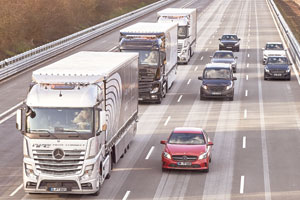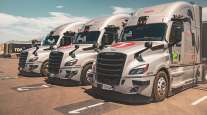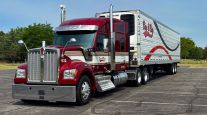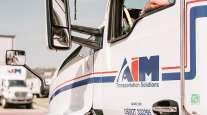Managing Editor, Features and Multimedia
Trucking Enters the Age of Automation

This story appears in the July 11 print edition of iTECH, a supplement to Transport Topics.
Self-driving trucks, once regarded largely as the stuff of science fiction, appear to be on the verge of becoming a reality on the nation’s highways.
Original equipment manufacturers have been demonstrating, researching and investing in various forms of truck automation in recent years, while several suppliers and technology startups have been positioning themselves to participate in this emerging field.
The move toward greater truck automation and driver-assistance capabilities “is clearly the direction of all OEMs, at least in the developed market,” said Joerg Rueger, global president of commercial vehicles at Bosch, a supplier of automated steering and sensor technologies.
“We see a big market potential with automated or semi-automated driving,” he said, describing it as one of the hottest topics in the commercial-vehicle sector.
This trend could lead to a future where self-driven, connected trucks improve the safety and efficiency of freight movement by easing the driver’s workload, enabling fuel-efficient platoons and communicating with nearby vehicles, traffic signals and road signs.
CHAT WITH SETH: TT Technology Editor Seth Clevenger takes your questions, noon EDT, July 18
BEST OF JULY iTECH: More stories, columns
The next steps down this path likely will take the form of advanced driver-assist features, such as lane keeping with automated steering, traffic-jam assistance and the first generation of platooning technology, all of which could become commercially available within the next few years.
These trucking developments are happening in parallel with the emergence of self-driving passenger cars. Virtually all global automobile manufacturers are at least dabbling in automation, including features ranging from parallel parking assistance to “autopilot” systems.
Across the board, heavy-duty truck OEMs are investing in automation — in one form or another — as an important part of the industry’s future.
Daimler Trucks has sparked global interest through a series of high-profile demonstrations over the past several years, including the May 2015 unveiling of its self-driving Freightliner Inspiration truck at the Hoover Dam.
The truck maker initially presented its self-driving system, known as Highway Pilot, on its Mercedes-Benz Future Truck concept vehicle in July 2014 in Germany. The company’s stated goal was to make the technology commercially viable by 2025.
In March, Daimler demonstrated an updated version of that system — Highway Pilot Connect — which added communications between vehicles to the package, enabling three semi-autonomous trucks to form a platoon on a public stretch of the German autobahn.
“Daimler has learned a lot over the past two years as we continue to develop, refine and test autonomous systems,” said Derek Rotz, director of advanced engineering at Daimler Trucks North America. “By and large, the technical development is still on track.”
He said the company has been working to enhance its technology by adding more sensor and control redundancies and designing the system to handle more “use cases,” or specific driving situations the vehicle might encounter.
Another ongoing task is improving the detection of and response to objects in front of the vehicle, be it a pedestrian or a vehicle, Rotz added.
“Advancements in this area can be achieved by sensor fusion, whereby information from the camera and radar systems is merged to create a more comprehensive picture of the surroundings,” he said.
Peterbilt Motors Co. has demonstrated self-driving capabilities on a prototype that uses a GPS-based navigation system to learn routes and repeat them.
That truck, a modified Model 579, incorporates an automated steering system from TRW, which now is part of ZF Friedrichshafen.
“We talk in terms of advanced driver-assist systems, because what we’re trying to do is make the driver safer and more efficient,” said Bill Kahn, Peterbilt’s principal engineer and manager of advanced concepts. Which form of truck automation would you most readily embrace?
Active braking systems, adaptive and predictive cruise control and active throttle control are available on today’s trucks, which leaves automated steering as the next big step.
“We’re really seeing an increase in the companies who want to bring computer-controlled steering systems to the market,” he said. “That’s really the last technology that we’ve been waiting on.”
In the near term, automated steering could enable Peterbilt to bring capabilities such as active lane keeping, traffic-jam assist and platooning to its trucks.
“Those are really things we can do in the next couple years,” Kahn said.
Kahn said the driver-assist technology under development at Peterbilt also would become available on parent company Paccar’s other brands — Kenworth Trucks and Europe-based Daf Trucks.
“We look to have a global solution for advanced driver-assist systems,” he said.
Volvo Group, the parent of Volvo Trucks and Mack Trucks, has been bullish on the prospect of platooning.
Last year, the OEM announced that its venture capital subsidiary had invested in truck-platooning firm Peloton Technology.
Göran Nyberg, president of Volvo Trucks North America, said at the time that platooning “will improve safety and fuel efficiency while also combating the costs associated with congestion.”
Charles Chilton, director of engineering and advanced technologies at Navistar International Corp., said driver-assist features are the building blocks that would enable autonomous trucks in the future.
One such capability is electronic steering, which is “definitely on our road map,” he said.
In addition to lane-keeping assistance, automated steering also could enable a truck to back itself into a dock, much like cars with parallel parking assist. Trucks also might gain the ability to hook up the fifth wheel automatically, he said.
“We’re still focused on the driver and how we can help the drivers do their job better,” Chilton said.
Navistar is participating in a research project on platooning with Texas A&M University to learn more about how these trucks will operate together in real-world environments. The company also is involved in testing at the University of Michigan’s Mcity facility, a simulated urban and suburban environment that Chilton described as “an incubator for an autonomous ecosystem.”
OEMs weren’t ready to put a specific price tag on the vehicle systems and services associated with autonomous driving, but Peterbilt’s Kahn predicted that the spread of self-driving technology in the automotive industry will help drive down the cost of radars, cameras and laser scanners. That, in turn, will make it more cost-effective for truck makers to include additional sensors and enable higher levels of automation.
While self-driving trucks may seem like a new development, the industry has been moving toward greater automation for some time.
Active safety systems, such as adaptive cruise control and collision mitigation, already can control acceleration and deceleration, leaving steering as the remaining key element to enable self-driving capabilities.
“In order to continue to improve safety systems, we have to look seriously at steering and the impact of steering on the driver-assistance systems,” said Fred Andersky, director of customer solutions at Bendix Commercial Vehicle Systems.
Bendix’s parent company, Munich-based Knorr-Bremse Group, recently took a major step in that direction by agreeing to purchase Tedrive Steering Systems, a supplier of steering-assist technology.
Through that acquisition, Knorr-Bremse said it will be able to offer automated driving functionalities such as active lane keeping on highways, platooning and autonomous yard maneuvering. The deal, announced June 1, is subject to approval by antitrust authorities.
Germany-based automotive supplier ZF Friedrichshafen AG also greatly bolstered its capabilities in this field with its May 2015 acquisition of TRW Automotive Holdings Corp. That transaction, first announced in September 2014, was valued at about $12.4 billion.
“With the TRW acquisition and the strength in the commercial-vehicle segment, ZF is ready to develop solutions for all levels and use cases of automated driving and driver-assist systems,” said Frank-Detlef Speck, senior manager of advanced engineering for commercial vehicle technology at ZF. “We can build extensively on synergies with passenger car development … which is an advantage of the new company that ZF has become.”
For highway driving, he predicted that systems with limited autonomy will be on the market by the end of this decade. With those initial systems, however, the human driver still will need to be ready to intervene.
“Systems where the driver hands over not only control but also responsibility are much further down the road in my point of view, not only from a technical standpoint, but also because of legislation and public acceptance,” he said. “This all needs time as well as experience and trust built over the years by the earlier limited systems.”
Meanwhile, Bosch is working to take its experience with automated steering systems and driver-assistance functions in passenger cars and carry that expertise over to commercial vehicles.
The company intends to be a “one-stop shop” for automated driving and driver-assist features to major truck OEMs worldwide, providing not just components but helping them develop comprehensive systems, Rueger said.
Bosch’s Servotwin electro- hydraulic steering system has been designed to support the implementation of automated steering and driver-assistance technologies.
Working in combination with a camera detecting lane markings to track where the road is going, that steering system can enable automatic lane keeping, he said.
After the introduction of lane-keeping support, a next step forward for the industry would be to develop the tool set needed for platooning with semi-autonomous driving.
Rueger said the 10% fuel-economy benefit for the following trucks within a platoon is highly attractive to fleets. “A double-digit number is really incredible.”
The Servotwin platform, which is a component on Daimler’s self-driving Inspiration truck, is in production in Europe, and Bosch is reaching out to customers to bring it to other regions as well, particularly North America.
Other future functionalities Bosch aims to support include emergency braking, side-view assist for blind-spot monitoring and automated maneuvering on logistics yards, said Rueger, who added that traditional mirrors will be replaced with digital mirrors using in-cab displays to show video from backward-facing cameras.
Jon Morrison, president of Wabco Holdings Americas, said his company’s approach, globally and in North America, has been to develop a base braking platform “that has the building blocks that support this path to automation.”
He pointed to the company’s modular braking system platform, which supports anti-lock braking and electronic braking systems.
Wabco also will become more involved in managing and integrating steering functionality, which “is obviously quite important and quite complicated but is a vital part of moving forward in terms of having a full platform to be able to manage an autonomous-driving vehicle.”
Morrison said the human-machine interface will be a crucial element of designing a self-driving system, as well.
“We still see the driver as being a very important part of the equation,” he said.
Matt Stevenson, president of Meritor Wabco, the North American joint venture of Wabco and Meritor Inc., said automation already is improving safety.
He said fleets using the company’s OnGuard collision mitigation system have seen rear-end collisions drop by more than 80%.
Despite those results, market penetration for collision-mitigation technology is only about 15% of all new Class 8 trucks sold in North America, he said.
“I think the more we automate the control of the vehicle, the higher the benefit to safety,” Stevenson said.
As limited self-driving systems become available on trucks, it will be important to ensure that drivers use the technology properly, said Brandon Nixon, CEO of Lytx Inc., a supplier of video-based safety systems.
Lytx said it intends to help fleets ensure that their drivers are prepared when the vehicle must hand control back to the human operator in response to a change in the environment.
“If they’re napping or reading a book, they’re not going to be ready,” Nixon said.
The emerging field of truck automation also is attracting technology startups.
Peloton Technology, for example, is nearing a commercial release of its platooning system.
And Otto, founded in January by former Google engineers, is developing an autonomous-driving aftermarket kit for trucks. The San Francisco-based firm said its technology will enable the millions of longhaul trucks already on the road today to drive themselves.
“We are developing a suite of sensors, software and truck enhancements coming together in a product that can be quickly outfitted on existing trucks,” Otto said on its website.
The system incorporates cameras, radar and lasers situated on top of the truck to track the vehicle’s surroundings while an onboard computer system and software make real-time driving decisions based on those sensors, the company said.
“Industries that are being disrupted are really well-suited to startups coming in and innovating,” said Quin Garcia, a managing director at AutoTech Ventures, a new venture capital firm focused on the ground-transportation sector.
The Palo Alto, California-based firm, launched in December, is investing in startups and helping them grow through partnerships with large corporations in the space, he said.
Pairing startups with corporations is “a good recipe for commercializing new transportation technology,” said Garcia, who also is a board member at Connected Signals, a predictive traffic-signal data firm, and a board adviser for Peloton and ridesharing company Lyft.
Corporations that have partnered with AutoTech include Wabco, Denso, Murata and Mahle, he said.




